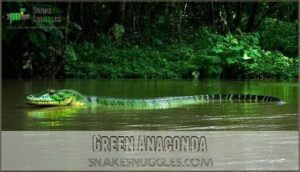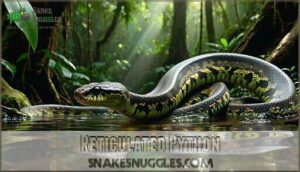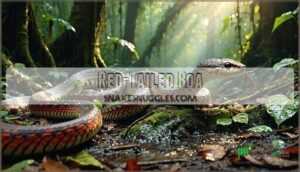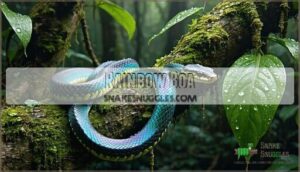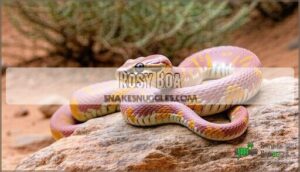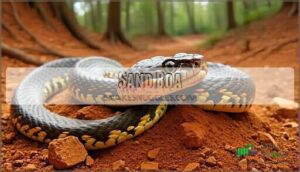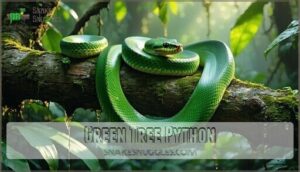This site is supported by our readers. We may earn a commission, at no cost to you, if you purchase through links.

These powerful predators kill by wrapping their muscular bodies around prey and squeezing until circulation stops.
Major species include the massive green anaconda, record-breaking reticulated python, popular Burmese python, and colorful red-tailed boa.
Smaller constrictors like rainbow boas, rosy boas, and sand boas pack surprising power despite their size.
Unlike venomous snakes, constrictors rely purely on their incredible strength and precise coiling technique.
From tropical rainforests to desert landscapes, these remarkable hunters have adapted to diverse environments worldwide.
Each species brings unique hunting strategies and physical adaptations that make them masters of their deadly craft.
These adaptations, combined with their precise coiling technique, enable constrictors to thrive in various ecosystems, showcasing their remarkable hunters abilities.
Table Of Contents
- Key Takeaways
- Constricting Snake Families
- Major Constrictor Species
- Unique Constricting Snakes
- Constricting Methods Techniques
- Conservation Status Types
- Frequently Asked Questions (FAQs)
- What types of snakes constrict?
- What is the most powerful constricting snake?
- Which snake can squeeze the hardest?
- What snake kills by constriction?
- What is a type of constricting snake?
- What venomous snakes use constriction?
- What is a large constricting snake?
- Which non-constrictor snakes sometimes use constriction?
- How does prey size affect constriction behavior?
- Do venomous snakes ever use constriction too?
- Conclusion
Key Takeaways
- You’ll find three main constrictor families dominating different regions – pythons in Africa and Asia, boas throughout the Americas, and anacondas ruling South American waterways, each with unique hunting adaptations.
- These snakes kill through precise muscle power, not venom – they wrap around prey and squeeze until circulation stops, with species like green anacondas generating crushing force exceeding 90 PSI.
- Size varies dramatically from giants to compact specialists – while reticulated pythons reach 32+ feet and anacondas weigh 550+ pounds, smaller species like rosy boas (22-35 inches) and sand boas pack surprising strength.
- Many constrictors face serious conservation threats – habitat destruction, illegal wildlife trade, and human encroachment threaten over 20 species, making protection efforts crucial for maintaining healthy ecosystems.
Constricting Snake Families
When you’re learning about constricting snakes, you’ll discover three main families dominate this hunting strategy: boas, pythons, and the massive anacondas.
These powerful serpents have spread across nearly every continent except Antarctica, with pythons primarily in Africa and Asia, boas in the Americas, and anacondas ruling South American waterways.
Boas
You’ll encounter boa constrictors across the Americas, where these powerhouse nonvenomous snakes dominate diverse habitats from rainforests to deserts.
Boa morphology features heat-sensing pits that detect warm-blooded prey, while their muscular bodies excel at snake constriction.
These constrictor snakes showcase remarkable boa behavior, ambushing everything from birds to mammals in their boa diet, making them apex predators requiring ongoing boa conservation efforts.
Pythons
You’ll find pythons in the Pythonidae family across Africa, Asia, and Australia.
These Old World constrictors differ from boas through their egg-laying reproduction and unique python anatomy featuring heat-sensing pits. Reticulated python, African rock python, Burmese python, and Indian python represent major species.
Python habitats range from rainforests to grasslands, where python behavior includes ambush hunting. Python diet consists of mammals and birds, while python evolution produced Earth’s longest snakes through millions of years of adaptation.
Some pythons are non-venomous constrictors.
Anacondas
Anacondas dominate South America’s wetlands as the world’s heaviest snake species, though they’re often confused with pythons.
These wetland giants pack more muscle per inch than any snake on Earth—pure aquatic power.
These semi-aquatic giants from the pythonidae family excel at underwater hunting, using their massive anaconda size** to ambush prey near riverbanks.
Despite anaconda myths suggesting they’re man-eaters, anaconda behavior focuses on fish, birds, and mammals.
Their anaconda habitat spans swamps and marshes, where anaconda diet includes caimans and deer.
Geographic Distribution
You’ll discover constricting snakes across every continent except Antarctica, with remarkable habitat variation shaping their evolution.
The pythonidae family dominates Asia and Australia, while anaconda snake populations thrive in South American wetlands. Regional endemism creates unique snake species adapted to specific climates.
Key distribution factors include:
- Climate Influence – Tropical zones support the largest snake habitats
- Invasive Species – Burmese pythons now colonize Florida’s Everglades
- Snake Identification – Geographic location often determines species presence
To manage this invasive species, the FWC encourages python removal efforts on both private and public lands.
Major Constrictor Species
You’ll encounter four giants that dominate the domain of constricting snakes, each representing the pinnacle of their evolutionary strategy.
These massive serpents—including the aquatic Green Anaconda and the record-breaking Reticulated Python—showcase how different species have perfected the art of crushing their prey through sheer muscular power, exemplifying the pinnacle of their evolutionary adaptations.
Green Anaconda
When you think about the world’s heaviest anaconda snake, you’re looking at South America’s apex aquatic predator.
Green anacondas dominate Amazon Basin snake habitats, with females reaching 30 feet and 550 pounds.
Their olive-green camouflage and dorsal nostrils make them perfect ambush hunters.
Large snakes like these showcase remarkable anaconda behavior, spending most time submerged while hunting.
Their anaconda diet includes caimans and deer, demonstrating why anaconda size matters for survival in wetland environments.
These snakes are known to inhabit tropical South America, thriving in the Amazon and Orinoco basins.
Reticulated Python
Reticulated pythons earn their title as record-breakers in the snake world, with verified specimens reaching 32.8 feet in length.
You’ll find these Southeast Asian giants showcasing incredible adaptability, swimming between islands and thriving in diverse habitats from forests to wetlands.
Key characteristics of reticulated pythons:
- Giant size: Typical adults measure 10-22 feet, weighing 100-270kg
- Scalation patterns: Complex geometric designs provide excellent camouflage
- Temperament: Generally docile but requires experienced handling due to strength
- Captive care: Demands spacious enclosures and consistent humidity levels
Unlike carpet python or ball python species, these large snakes demonstrate remarkable swimming abilities that rival aquatic specialists.
Their snake behavior includes ambush hunting, while their snake diet consists of mammals and birds.
Conservation concerns remain minimal due to their wide distribution, though habitat pressure affects local populations.
Burmese Python
Moving from the reticulated python’s record-breaking length, you’ll find the Burmese python presents different challenges.
Adult Burmese size reaches 16-23 feet, making them formidable constrictors. As invasive species in Florida, they’ve demonstrated remarkable adaptability and prolific breeding.
Their calm temperament makes captive care manageable, though their snake behavior includes powerful constriction capable of subduing large prey. Multiple morph variations exist in captivity.
These reptile facts highlight their low detectability in natural habitats, complicating conservation efforts. Their character as both magnificent predators and ecological threats illustrates complex reptile conservation challenges facing modern snake populations.
Red-Tailed Boa
You’ve just read about the Burmese python’s power—now, meet the Red-Tailed Boa.
Known for its striking red tail, impressive Boa Morphology, and adaptability to rainforests and semi-deserts, this snake’s Red-Tail Habitat stretches across the Americas.
With calm Temperament, varied Color Morphs, and ovoviviparity, it’s a favorite in Captive Care.
They require specific humidity levels, so be sure to maintain 60-80% for ideal health.
Learn about its type, classification, description, and snake conservation.
Unique Constricting Snakes
While most constrictors follow similar hunting patterns, you’ll find some species have evolved remarkable specializations that set them apart from their larger cousins.
These unique hunters include the iridescent Rainbow Boa with its stunning color displays, the compact Rosy Boa perfectly adapted to arid environments, the Sand Boa that hunts by burying itself in desert sands, and the Green Tree Python with its incredible heat-sensing abilities and arboreal lifestyle, showcasing a range of adaptations such as the arboreal lifestyle.
Rainbow Boa
You’ll notice the rainbow boa’s iridescent scales create stunning rainbow coloration through light refraction, making this type stand out among constrictors.
This classification includes females reaching 2 meters with muscular morphology designed for forest hunting. Their temperament issues in captive care stem from aggressive behavior when threatened.
These snakes require specific habitat humidity levels, thriving in Central and South American rainforests. Heat-sensing pits aid prey detection, showcasing remarkable adaptations that make snake conservation efforts essential for protecting this species’ unique description.
Maintaining proper humidity is essential, as dry conditions invite respiratory infections.
Rosy Boa
You’ll find the Rosy Boa among the smallest constrictor variety, typically measuring 22–35 inches with a heavy-bodied build.
This docile type rarely bites, often rolling into a defensive ball when threatened.
Their natural habitat spans southwestern U.S. deserts and rocky scrublands. Size variation shows females slightly larger than males.
Multiple Rosy Boa morphs display beige, blue, or rose coloration with distinctive lengthwise stripes. Captive breeders often focus on specific Rosy Boa colors for sale.
Their calm temperament makes captive care manageable, though proper classification requires understanding their specific taxonomy and description requirements for desert-dwelling constrictors.
Sand Boa
Why do some snakes prefer living underground? Kenyan sand boas represent this burrowing type perfectly, averaging just 15-32 inches in length with specialized wedge-shaped heads for efficient digging.
Sand Boa Care requires understanding their substrate considerations—they need loose soil for natural burrowing behavior. These constrictors exhibit interesting temperament variations, remaining largely docile despite their ambush hunting style.
Morph selection offers various color patterns, while breeding challenges include managing their live-bearing reproductive classification within this unique snake species variety. Proper sand boa habitats are essential for their well-being.
Green Tree Python
You’ll discover Green Tree Python species showcase remarkable arboreal adaptations for life in emerald habitat canopies.
This python type exhibits stunning color morphs, transforming from yellow juveniles to vibrant green adults.
Their docile temperament makes captive care manageable, though their specific classification requires understanding unique characteristics.
Heat-sensing pits distinguish this variety from similar constrictors, enabling precise prey detection among tropical branches, utilizing heat-sensing pits.
Constricting Methods Techniques
When you watch constrictors hunt, you’ll see they’ve perfected four deadly techniques that make them some of nature’s most efficient predators.
These serpents combine stealth ambush tactics with precise coiling mechanics, advanced heat-sensing abilities, and specialized swallowing adaptations to successfully capture and consume prey much larger than their heads.
Ambush Predation
You’ll find constricting snakes master the art of patience, waiting motionless for hours until prey ventures within striking distance.
This type of hunting relies on advanced Camouflage Techniques that make them nearly invisible against bark, leaves, or rocky surfaces.
Their Strike Speed reaches lightning-fast velocities, while Sensory Adaptations like heat-sensing pits detect warm-blooded targets.
Prey Selection depends on Habitat Preference, with each variety specializing in specific classification of animals within their environment.
Coiling and Squeezing
Once you’ve positioned yourself for the perfect ambush, the real power begins.
This is where muscle meets precision—every coil counts when survival depends on the perfect squeeze.
Your coil strength determines everything – larger species like anacondas generate crushing forces exceeding 90 PSI, while smaller boas rely on precise placement around critical organs.
The squeeze duration varies by prey size, with constrictor physiology perfectly adapted for sustained pressure.
These evolutionary advantages showcase nature’s brilliant biology: each coiling type matches the species’ hunting requirements exactly, highlighting the importance of precise placement.
Prey Detection Methods
Beyond their powerful coiling ability, constrictors rely on sophisticated sensory systems to locate prey.
Each type of constrictor has evolved specialized detection mechanisms that make them formidable hunters in their natural ecology.
Here’s how these biology marvels track their targets:
- Infrared Receptors – Heat-sensing pits detect warm-blooded prey from several feet away
- Vibration Sensing – Ground tremors reveal approaching animals through specialized scales
- Chemical Signals – Jacobson’s organ processes scent trails and pheromones
- Visual Acuity – Motion-detecting eyes spot movement in low-light conditions
- Electroreception – Some species detect electrical fields from muscle contractions
This sensory arsenal allows constrictors to hunt effectively regardless of lighting conditions or environmental obstacles.
Swallowing Mechanisms
Dislocating their jaws like nature’s ultimate lockpick, these serpents demonstrate remarkable skull flexibility that’s pure biological genius.
You’ll witness incredible adaptations where species showcase jaw mechanics that would make any engineer envious.
| Mechanism | Function |
|---|---|
| Gape Size | Accommodates prey 3-5x head width |
| Jaw Flexibility | Quadrate bone allows 150° jaw opening |
| Esophagus Expansion | Stretches dramatically during swallowing |
Their skull structure features loosely connected bones that work like a biological hinge system.
Digestive enzymes begin breaking down prey immediately, while specialized jaw characteristics and swallowing behavior showcase millions of years of evolutionary perfection.
Conservation Status Types
You’ll find that many constricting snakes face serious conservation challenges, with some species teetering on the edge of extinction due to habitat destruction and illegal collection.
Understanding these threats helps you appreciate why protecting these remarkable predators matters for maintaining healthy ecosystems worldwide, and this is crucial for their conservation.
Threatened Constrictor Species
You’ll find that many constrictor species face serious threats in today’s changing world.
Over 20 types of large constricting snakes appear on conservation watch lists, with their biology making them particularly vulnerable to environmental changes and human pressures.
The boa constrictor, while not currently facing the same level of threat as some other species, is still impacted by habitat destruction.
- Indian Python: Listed as Near Threatened with fewer than 10,000 mature individuals remaining in nature
- Madagascar Boa: Classified as Vulnerable due to ongoing habitat fragmentation across its native range
- Rosy Boa: Faces regional vulnerability from localized pressures despite stable global populations
- Anaconda Populations: Unknown conservation status with suspected regional declines throughout Amazon Basin areas
Impact of Habitat Loss
When deforestation destroys nature’s balance, constricting species lose critical habitat faster than they can adapt.
You’ll find that wetland drainage and urbanization create fragmented environments where Prey Availability drops dramatically, forcing Increased Competition among survivors.
Human Encroachment reduces Genetic Diversity by isolating populations, while Climate Change alters the delicate biology these species depend on for survival.
Illegal Wildlife Trade
You’ll encounter constricting snakes caught in Smuggling Routes that span continents, feeding Consumer Demand for exotic pets and luxury goods.
Online Markets have made purchasing these species easier than ever, creating Enforcement Challenges for authorities tracking shipments.
The illegal trade threatens nature through these Conservation Impacts:
- Population depletion – Python skins represent nearly half of all reptile leather exports worldwide
- Species categorization confusion – DNA testing reveals up to 60% of harvests are illegal in some regions
- Biology disruption – Trading removes breeding adults, affecting natural characteristics and reproduction cycles
Conservation Efforts Programs
While illegal trade threatens constrictor populations, conservation groups are fighting back.
You’ll find CITES regulations controlling international python and boa commerce, while breeding programs maintain genetic diversity for species like reticulated pythons.
Community-based monitoring in Peru’s Amazon supports sustainable anaconda use, and Anaconda support programs are essential for their survival.
Anti-poaching efforts and public awareness campaigns reduce illegal collection rates across Southeast Asia, protecting habitat preservation initiatives.
Frequently Asked Questions (FAQs)
What types of snakes constrict?
Over 2,700 snake species use constriction to subdue prey.
You’ll encounter pythons, boas, kingsnakes, and rat snakes employing this lethal embrace.
These powerful predators wrap coils around victims, tightening with each exhale until circulation stops, using a lethal method to capture their prey.
What is the most powerful constricting snake?
You’ll find the green anaconda reigns supreme as the most powerful constrictor, capable of generating crushing force exceeding 90 PSI—enough pressure to stop your heart within minutes.
Which snake can squeeze the hardest?
You’ll encounter the green anaconda as nature’s ultimate crusher, delivering bone-crushing pressure up to 90 PSI. This South American giant can squeeze with enough force to stop your heart within seconds.
What snake kills by constriction?
You’ll encounter pythons, boas, and anacondas as the main killers using constriction.
These powerful constrictors wrap around prey, tightening with each exhale until circulation stops, causing death through cardiac arrest rather than suffocation.
What is a type of constricting snake?
Coiled like nature’s living rope, you’ll discover pythons are powerful constrictors. These magnificent serpents wrap around prey, squeezing until circulation stops, then swallow their meal whole using incredible jaw flexibility.
What venomous snakes use constriction?
Most venomous snakes don’t constrict their prey, but you’ll find some rattlesnakes and certain vipers like Russell’s viper occasionally use constriction alongside their venom to secure struggling prey.
What is a large constricting snake?
Ironically, you’re asking about "large" constrictors when size matters less than squeezing power.
Reticulated pythons, Burmese pythons, and green anacondas top the list.
These muscular giants can reach 20-30 feet, using their coils to suffocate prey through constriction.
Which non-constrictor snakes sometimes use constriction?
You’ll encounter several non-constrictor species that occasionally employ constriction, including some vipers, colubrids like rat snakes, and even certain venomous species when subduing particularly large or struggling prey items.
How does prey size affect constriction behavior?
Larger prey triggers more intense constriction.
You’ll see snakes applying greater force and maintaining longer holds when subduing bigger animals, while smaller prey receives gentler, briefer pressure to avoid unnecessary energy expenditure.
Do venomous snakes ever use constriction too?
You’ll discover that some venomous snakes actually combine both weapons – they’ll bite to inject venom, then coil around struggling prey to finish the job more efficiently and securely.
Conclusion
Like master craftsmen perfecting their trade over millions of years, the diverse types of constricting snakes showcase nature’s incredible engineering.
You’ve discovered how these remarkable predators use strength rather than venom, from massive anacondas to compact sand boas.
Understanding their hunting methods, habitats, and conservation challenges helps you appreciate these misunderstood animals.
Whether you’re a wildlife enthusiast or simply curious about nature’s power, these serpents demonstrate evolution’s ability to create perfect killing machines through pure mechanical force and precision.
- https://snakesarelong.blogspot.com/2017/08/how-many-snakes-are-venomous-constrictors.html
- https://en.wikipedia.org/wiki/Central_African_rock_python
- https://a-z-animals.com/animals/snake/snake-facts/strongest-snakes-in-the-world/
- https://www.nhm.ac.uk/discover/what-is-the-biggest-snake-in-the-world.html
- https://pmc.ncbi.nlm.nih.gov/articles/PMC3367750/

